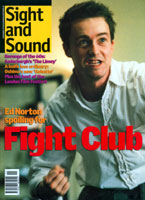Primary navigation

USA 1998
Reviewed by Charles Taylor
Our synopses give away the plot in full, including surprise twists.
Titles inform us that the footage we are about to see was shot by three student film-makers who went into the woods surrounding the town of Burkittsville, Maryland, and were never heard from again. The footage was discovered by a search party a year later.
Burkittsville, 1994. Heather, a director, Josh, a cameraman, and Mike, a soundman, head for the woods to investigate the local legend of the Blair Witch, a spirit blamed for various disappearances and the murders of several children many years before. After stocking up on provisions for a three-day trip and interviewing locals for their stories about the Blair Witch, the three set out. Things immediately start to unravel. The map Heather relies on leads the three in circles, and her insistence on filming everything, including the trio's arguments, exacerbates the tension. Soon they're awoken in the middle of the night by the sounds of children screaming. Strange piles of rocks and stick figures made out of branches are left outside their tent.
Shortly after Josh finds his belongings strewn over their campsite, he disappears. A few days later Heather finds a bundle made of torn strips of Josh's shirt with an unidentified piece of bloody viscera inside. With food and hope gone, Heather and Mike stumble on a house in the woods...
Glee is understandable when a small-budget ($25,000) independent film not only rivals Hollywood's summer blockbusters at the box office (The Blair Witch Project has taken more than $100 million and counting) but also captures the public's imagination in a way no Hollywood release of the season has managed. There's some poetic justice in the idea that a film made by unknowns and shot on video with no stars and no special effects could trounce its prepackaged competition. The ways 'entertainment reporting' has elevated the business side of movies over discussion of their quality have resulted in moviegoers who are cynically knowing about deals and grosses but conditioned to accept the junk shovelled at them. So it's not surprising that audiences respond to the zero-style of Blair Witch. With special effects announcing nothing so much as their own price tag, this picture's flat replication of reality, achieved using handheld video, and its ability to scare audiences witless with nothing more than shots of rocks and twigs are genuinely jolting. Because the film is so deliberately lacking in 'art' in much the same way Night of the Living Dead (1968) was, you can be lulled into thinking what you're seeing is actually happening.
This has been encouraged by the film-makers Daniel Myrick and Eduardo Sanchez presenting the film as a documentary, assigning their characters the same names as the actors who play them, and their now-notorious filming method. Given camcorders, the three actors were sent into the woods for a week (the provisions we see them buying are what they actually lived on). Each morning they picked up written directions from the film-makers on what to shoot that day. The finished product is edited from the footage shot by the actors. In the interviews that accompanied the US release, Sanchez and Myrick boasted about how they induced real fright by waking their actors in the middle of the night with tapes of children screaming or, in the climactic scene, having camouflaged crew members leap out of the darkness to grab Heather Donahue. "We wanted this thing to be 100 per cent real," Sanchez told Spin. "We didn't want any of that movie shit."
But as the megalomaniacal director played by Peter O'Toole in The Stunt Man (1979) asked, "How tall is King Kong?" Don't Myrick and Sanchez know that movies are fake? Apart from the sadism of keeping your (non-union) cast hungry, cold and terrified for a week, there's the question of why you hire actors if you don't trust them to act? Certainly the unmediated hysteria we see the actors sliding into is part of what makes the film so terrifying. It's also what makes it so unpleasant. The method makes nonsense of the implied criticism of Heather's inability to put down her camera and deal with the reality in front of her. How can you take that criticism seriously from a film designed to eke every ounce of real misery and terror from its cast?
Myrick and Sanchez's method may be the opposite of Hollywood's, but by banishing psychology, characterisation and finally humanity from their film, by excluding anything but sensation, the effect is ultimately not that much different from that of, say, Armageddon. The most persistent Blair Witch myth is that the film eschewed the usual methods of marketing. In fact, no film in recent memory has been as shrewdly pre-sold as this one. The buzz it generated at the Sundance Film Festival earlier this year was sustained via a website, an hour-long 'documentary' on the history of the Blair Witch (shown on US primetime television three nights before the film opened) and pre-release displays of "artefacts" in the lobbies of theatres. Currently you can purchase a Blair Witch comic, a film companion book, t-shirts and a soundtrack. Now comes word that a sequel is on the way. The most amusing thing about Hollywood's hottest new 'directors' is that they haven't actually directed anything. The producer who takes credit while doing no work has long been a staple of Hollywood satire. Myrick and Sanchez have gone that stock figure one better, as they told one interviewer, sitting in a burger joint laughing about the actors - hungry, cold and scared in the woods - who shot the movie Myrick and Sanchez have taken credit for. Somewhere, P. T. Barnum is smiling.